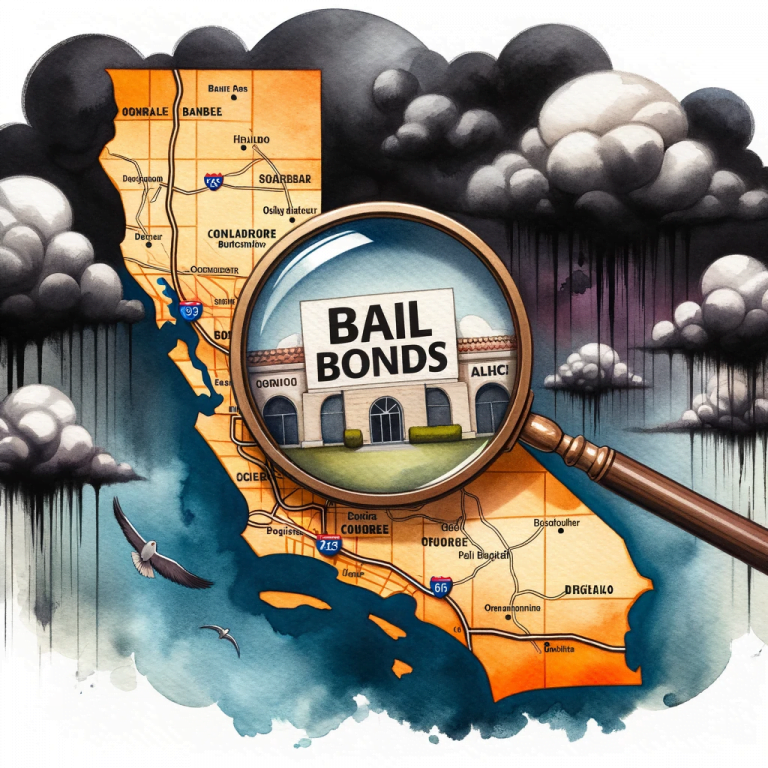Bail Bonds Unleashed: The Passionate Evolution in California

Table of Contents
The future of bail bonds in California is a topic of significant debate and change, as the state grapples with issues of criminal justice reform and equity. With the passing of Senate Bill 10 in 2018, California is set to eliminate cash bail, replacing it with a risk assessment system. This shift is expected to drastically alter the bail bonds industry, potentially leading to its extinction. However, the implementation of this law has been delayed due to legal challenges and a pending referendum. Therefore, the future of bail bonds in California remains uncertain, with potential outcomes ranging from complete transformation to total elimination.
Exploring the Future of Bail Bonds in California: Predictions and Possibilities
The future of bail bonds in California is a topic of considerable interest and debate, given the state’s recent legislative changes and ongoing discussions about criminal justice reform. As we look ahead, several predictions and possibilities emerge, reflecting a range of perspectives on what the future may hold for this critical aspect of the justice system.
One of the most significant developments in recent years was the passage of Senate Bill 10 in California, which aimed to eliminate cash bail entirely. The bill, signed into law in 2018, proposed a system where pretrial release decisions would be based on an individual’s assessed risk to public safety and their likelihood of returning to court, rather than their ability to pay a bail amount. However, the bill was overturned by voters in the 2020 election, signaling a resistance to such drastic changes and suggesting that cash bail, and by extension bail bonds, will continue to play a role in California’s justice system for the foreseeable future.
Despite this, the debate around bail reform is far from over. Critics of the current system argue that it disproportionately affects low-income individuals and communities of color, who are often unable to afford bail and therefore more likely to remain in custody until their trial. This has led to calls for a more equitable system, which could potentially involve changes to the role and function of bail bonds.
One possibility is a shift towards more use of unsecured bonds, which do not require upfront payment unless the defendant fails to appear in court. This would allow individuals to be released pretrial without the financial burden often associated with secured bonds, while still providing a monetary incentive for them to return to court. Another option could be increased use of non-monetary conditions for release, such as electronic monitoring or regular check-ins with a pretrial services officer.
At the same time, there is also a growing interest in exploring alternatives to the traditional bail system altogether. Some suggest a move towards a more preventative approach, focusing on addressing the root causes of crime and providing support and resources to help individuals avoid entering the justice system in the first place. Others propose a greater emphasis on restorative justice practices, which aim to repair the harm caused by crime and reduce reoffending, rather than simply punishing the offender.
In any case, it is clear that the future of bail bonds in California will be shaped by ongoing discussions about fairness, equity, and the role of money in the justice system. While the exact path forward remains uncertain, it is likely that we will see continued efforts to reform and innovate in this area, reflecting a broader societal shift towards a more holistic and nuanced understanding of justice.
In conclusion, the future of bail bonds in California is a complex and evolving issue, with a range of potential outcomes. Whether it involves changes to the existing bail bond system, a move towards alternative forms of pretrial release, or a complete overhaul of the justice system itself, it is clear that this is a topic that will continue to be at the forefront of criminal justice reform efforts in the years to come. As we navigate these changes, it will be crucial to ensure that any new approaches are guided by principles of fairness, equity, and respect for the rights and dignity of all individuals.
Technological Innovations Shaping the Future of Bail Bonds in California
The future of bail bonds in California is being shaped by a series of technological innovations that are transforming the industry. These advancements are not only streamlining the bail bond process but also making it more accessible and transparent for all parties involved.
One of the most significant technological innovations impacting the bail bond industry is the advent of online platforms and mobile applications. These digital tools have made it possible for bail bond agents to offer their services remotely, thereby eliminating the need for clients to physically visit their offices. This has been particularly beneficial during the COVID-19 pandemic, where social distancing measures have necessitated remote operations. Clients can now apply for bail bonds, submit necessary documents, and make payments online, making the process faster and more convenient.
Moreover, these online platforms are equipped with advanced security measures to ensure the confidentiality and safety of clients’ personal information. They also provide a transparent platform where clients can track the progress of their bail bond application, receive updates, and communicate with their bail bond agent in real time.
Artificial Intelligence (AI) is another technological innovation that is poised to revolutionize the bail bond industry in California. AI can be used to analyze a defendant’s risk profile, taking into account factors such as their criminal history, employment status, and community ties. This can help bail bond agents make more informed decisions about whether to issue a bond and at what amount. AI can also automate routine tasks, freeing up bail bond agents to focus on more complex aspects of their work.
Blockchain technology, known for its role in cryptocurrencies like Bitcoin, is also making its way into the bail bond industry. Blockchain can provide a secure, transparent, and immutable record of all transactions related to a bail bond. This can help prevent fraud and disputes, and ensure that all parties are held accountable.
In addition to these technological innovations, changes in legislation are also shaping the future of bail bonds in California. In 2018, the state passed a law to eliminate cash bail, replacing it with a risk assessment system. However, this law has been put on hold pending a referendum in 2022. If it is upheld, it could significantly change the bail bond industry, potentially reducing the demand for bail bonds. However, it could also open up new opportunities for bail bond agents to offer their expertise in risk assessment and management.
While these technological innovations and legislative changes present challenges, they also offer opportunities for the bail bond industry in California. Bail bond agents who embrace these changes and adapt their business models accordingly will be well-positioned to thrive in the future. They can leverage technology to improve their services, increase their efficiency, and meet the evolving needs of their clients.
In conclusion, the future of bail bonds in California is being shaped by a combination of technological innovations and legislative changes. These developments are transforming the industry, making it more efficient, transparent, and accessible. As the industry continues to evolve, bail bond agents in California will need to stay abreast of these changes and adapt their practices accordingly to ensure their continued success.
The Impact of Legal Reforms on the Future of Bail Bonds in California
The future of bail bonds in California is poised for significant transformation, largely due to the impact of legal reforms. These changes are set to redefine the bail bonds industry, with the potential to alter the landscape of the criminal justice system in the state. The legal reforms, which are primarily aimed at ensuring fairness and equality in the justice system, are expected to have far-reaching implications on the bail bonds industry.
The most significant of these legal reforms is Senate Bill 10, signed into law by Governor Jerry Brown in 2018. This landmark legislation effectively eliminates the cash bail system in California, replacing it with a risk assessment system. Under this new system, individuals arrested for a crime will be evaluated based on their perceived risk to public safety and their likelihood of appearing in court. This risk assessment will then determine whether the individual will be detained until trial or released.
The introduction of this risk assessment system is a significant departure from the traditional cash bail system, where individuals could secure their release by posting a certain amount of money as bail. This system has been criticized for favoring the wealthy, who can afford to post bail, and penalizing the poor, who often remain in jail because they cannot afford the bail amount. The new risk assessment system aims to address this inequality by focusing on the individual’s risk rather than their financial capacity.
However, this shift from cash bail to risk assessment has significant implications for the bail bonds industry. Traditionally, bail bondsmen have played a crucial role in the cash bail system, providing the necessary funds for individuals who cannot afford to post the full bail amount. With the elimination of cash bail, the role of bail bondsmen is likely to diminish, potentially leading to the decline of the bail bonds industry.
Despite these potential challenges, some industry experts believe that the bail bonds industry can adapt to these changes. They argue that bail bondsmen could transition into a role similar to that of probation officers, monitoring individuals who have been released pending trial. This would require bail bondsmen to develop new skills and adapt to a new role, but it could ensure the survival of the industry in the face of legal reforms.
The legal reforms also raise questions about the potential impact on public safety. Critics of the risk assessment system argue that it could lead to the release of individuals who pose a risk to public safety. However, proponents of the system argue that it is a more fair and equitable approach, ensuring that individuals are not penalized simply because they cannot afford to post bail.
The future of bail bonds in California faces significant changes due to legal reforms. The potential elimination of cash bail and the new risk assessment system may reduce the traditional role of bail bondsmen. Yet, the industry might adapt and find ways to stay relevant. These reforms could reshape California’s criminal justice system, impacting public safety and justice system equality.
California’s bail bonds future is uncertain with ongoing legislative debates. A growing movement pushes for bail reform, possibly ending cash bail. This could lead to a decline in bail bond use. However, until laws change, the bail bonds industry persists.
Has a close friend or family member been incarcerated in California? Discovering that someone dear to you is detained can be deeply unsettling. Reach out to an agent at Cal West Bail Bonds for assistance.


